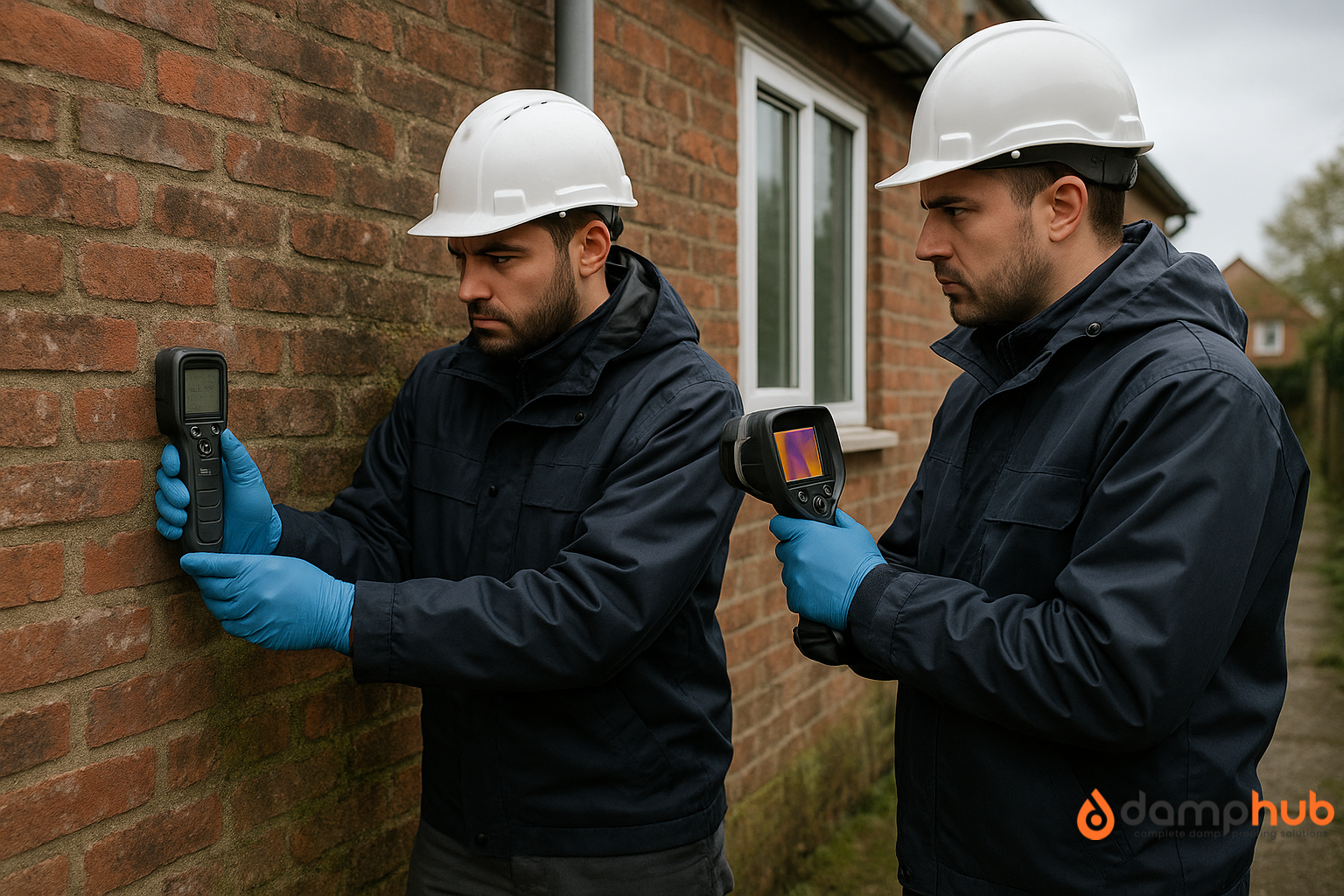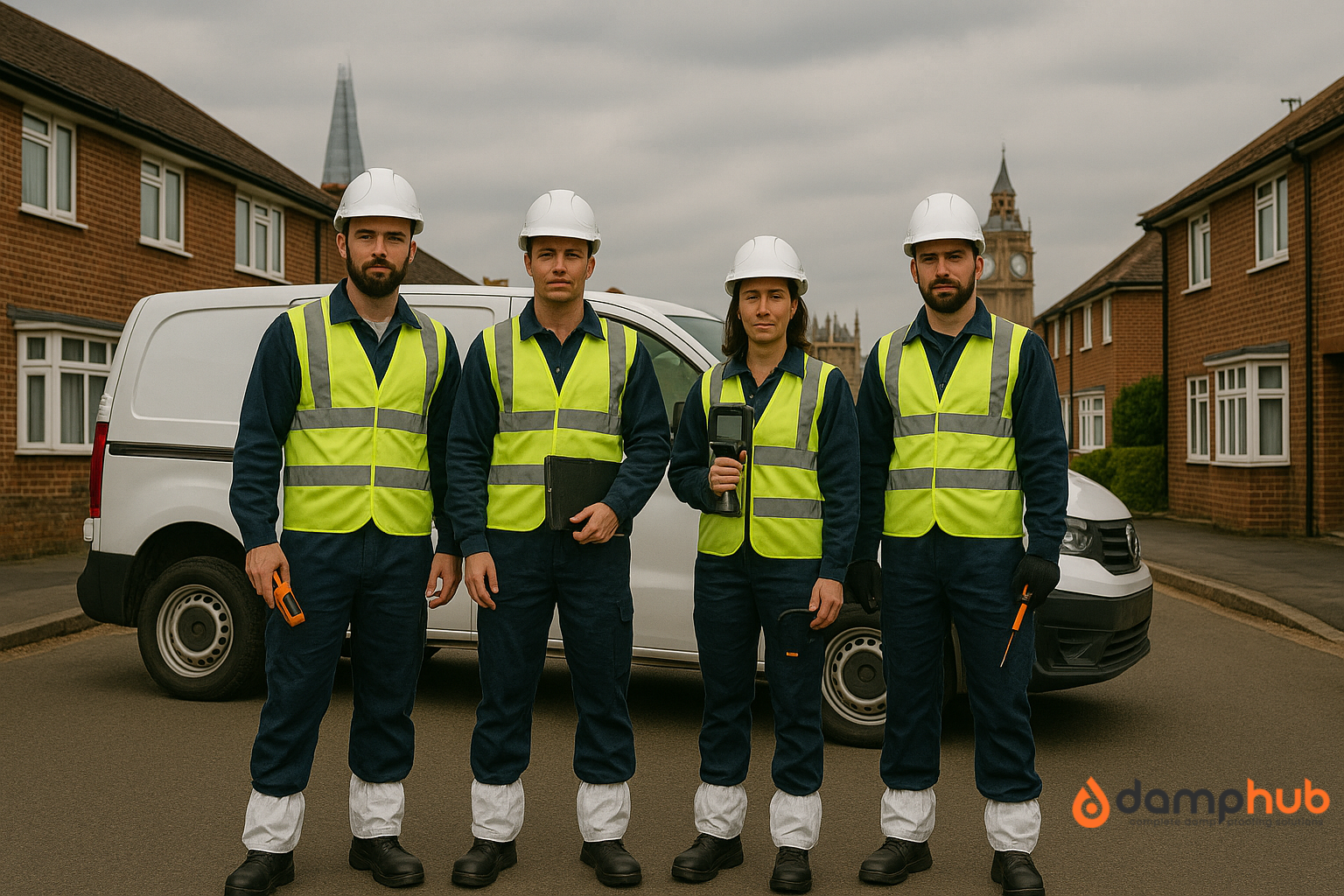
A damp survey is a critical diagnostic procedure that evaluates moisture-related issues of a building.
It is the process of identification, examination, and the provision of solutions for damp conditions capable of impairing the structural stability, cleanliness, and indoor air quality of a property.
Not only is dampness unattractive, but it also triggers health problems and costly repairs if not addressed.
With the complexity and potential consequences of damp, it is significant that only professionally qualified persons should conduct such surveys.
And this leads us to our discussion: Who can carry out a damp survey?
This essay examines the roles, qualifications, and duties of professionals who can undertake damp surveys, as well as the reasons behind the need to select the best expert for the job.
The Importance of a Damp Survey
Prior to discussing who can perform a damp survey, one needs to comprehend its significance.
There are various types of damp, such as rising damp, penetrating damp, condensation, and plumbing system leaks.
All of these have varying causes and remedies. An incorrect diagnosis may result in the wrong treatment, money spent for no use, and continued damage.
The best damp survey companies in London assist with:
- Identifying the origin and extent of the damp issue.
- Determining the nature of the damp problem in the property.
- Suggesting the relevant remedial actions.
- Supplying the documentation that is essential for legal or insurance reasons, particularly on the sale of the property.
Due to these considerations, it is essential that the survey is carried out by an experienced and competent professional.
Who Can Carry Out a Damp Survey? Professionals Trained to Conduct Damp Surveys
1. Certified Surveyor in Remedial Treatment (CSRT)
One of the best-known in the UK is the Certified Surveyor in Remedial Treatment (CSRT).
The Property Care Association (PCA), the trade body for property care and damp-proofing, issues the certification.
Those who hold this name have:
- Undergone intense training and tests.
- Shown expertise in the construction of buildings, diagnosis of moisture, and remedial treatments.
- Practical experience in the identification and treatment of damp-related issues.
CSRT-accredited surveyors are especially well-trained to identify rising damp, timber decay, woodworm, and fungal infestation.
2. Chartered Building Surveyors
Another highly trained professional who may conduct a damp survey is a Chartered Building Surveyor, in most cases, a member of the Royal Institution of Chartered Surveyors (RICS).
They:
- Retain academic qualifications in building surveying or construction-related subject areas.
- Have fulfilled a period of formal training and passed the RICS Assessment of Professional Competence (APC).
- Provide an unbiased and complete perspective of the building’s state.
RICS surveyors can carry out general building surveys or condition reports encompassing damp assessment.
They will not necessarily have specialist expertise only in damp but can generally recognise it through general inspections and suggest whether or not a damp expert is necessary.
3. Damp Proofing Specialists
Numerous specialist damp proofing firms provide free or chargeable damp surveys.
Such firms usually have technicians with different qualifications and degrees of experience.
It is vital to ensure that the surveyor:
- Is qualified and experienced in damp diagnosis.
- Works for a company belonging to an established trade body like the PCA.
- Does not have a conflict of interest (i.e., attempting to sell unnecessary treatments).
Some firms provide “free surveys”, but these are often little better than sales calls, with minimal diagnostic potential.
Homeowners need to be wary and require that any recommendations made must be supported by an objective, evidence-based report.

👉 Must read: How to Treat Damp Walls Internally: A Step-by-Step Guide
4. Independent Damp Surveyors
Independent damp surveyors are individuals operating independently of large damp-proofing firms.
They provide objective reports, and frequently, property buyers and sellers seek them out for second opinions or to end disputes.
They tend to possess qualifications such as:
- CSRT (Certified Surveyor in Remedial Treatment)
- CSSW (Certified Surveyor in Structural Waterproofing).
- Membership in professional institutions like RICS or PCA.
The advantage of employing an independent damp surveyor is that they are objective.
Because they are not selling remedial work, their conclusions are more likely to be unbiased and accurate.

What Qualifications Should You Look For?
When you select someone to conduct a damp survey, look for the following credentials:
- CSRT or CSSW Certification
Demonstrates in-depth knowledge of remedial treatment and structural waterproofing.
- PCA Membership
Property Care Association members have to adhere to high standards of conduct, training, and ongoing professional development.
- RICS Accreditation
RICS chartered surveyors are trained to recognise structural and environmental problems, such as damp.
- Experience and Reputation
An established record of identifying and solving damp problems is vital. Check for reviews, case studies, or recommendations.
- Insurance and Professional Indemnity
Make sure that the surveyor has sufficient professional indemnity insurance in the event of mistakes or disagreements.

Who Should Not Perform a Damp Survey?
Some property professionals will have some construction knowledge, but may not be trained to perform a formal damp survey.
These are:
- General builders or handymen who have no specific training in damp diagnostics.
- Estate agents or letting agents – although they might spot damp, they are not trained to diagnose or suggest treatments.
- DIY enthusiasts or homeowners with no professional training.
- Surveyors who work for companies that supply treatments, except when qualifications and impartiality are checked.
Incorrect diagnosis by incompetent people can lead to money being wasted, inappropriate treatments, or a failure to deal with the issue.
Cost of a Damp Survey
The price of a damp survey can be quite variable:
- Free from companies that want to sell treatments, but watch out for biased reporting.
- £100–£400+ for an independent damp survey, depending on the size and location of the property.
👉 Must read: How to Remove Damp from Walls: The Ultimate Guide

More comprehensive homebuyer or building condition reports from chartered surveyors can be even more expensive but address a wider variety of issues.
For most people, spending money on a paid-for survey by an independent, professional expert can pay off in the long term by saving tens of thousands of pounds.
A damp survey is a crucial component of the upkeep of a building’s health, particularly in damp-risk areas or older structures.
The responsibility of conducting a damp survey must only be given to competent professionals, including CSRT surveyors, RICS-approved building surveyors, independent damp experts, or company technicians working for PCA-registered businesses.
Their training, experience, and neutrality have a direct impact on the precision and utility of the report.
Selecting the appropriate professional is not merely addressing the damp issues at the moment, but also protecting the future worth and solidity of the property.
Both involve the seriousness that it should be treated with, and a request for professionals whose training and credentials are traceable and credible.
FAQs
What qualifications should a damp surveyor have?
A qualified damp surveyor should have training in building diagnostics and moisture assessment. In the UK, look for certifications like:
– CSRT (Certified Surveyor in Remedial Treatment)
– CSSW (Certificated Surveyor in Structural Waterproofing)
These are awarded by the PCA (Property Care Association).
Some surveyors may also have background qualifications in building surveying, construction, or structural engineering.
How do you prepare a house for a damp survey?
– Move furniture away from walls so the surveyor can access affected areas.
– Pull back carpets if damp is suspected on the floors.
– Make sure the loft, cellar, and any basements are accessible.
– Remove clutter near skirting boards, vents, and pipework.
– Provide access to any damp patches previously noticed.
This helps ensure accurate readings and a thorough inspection.
What does a damp report look like?
A damp report is a written document prepared after the survey.
It usually includes:
– A description of the areas inspected
– Moisture readings taken with meters
– Observations of visible damp signs (like stains, salts, or mould)
– The type of damp identified (rising, penetrating, or condensation)
– Likely causes and recommendations for treatment
Some reports also include photos, diagrams, and a quote for repair work if requested.
What causes high damp readings on surveys?
High moisture readings can be caused by:
Rising damp – moisture drawn up through walls from the ground
Penetrating damp – water entering through walls or roofs
Condensation – moisture from the air settling on cold surfaces
Leaks – from plumbing, gutters, or roofs
Also, salts in the wall can attract moisture, keeping readings high even after the original source is fixed. That’s why interpretation by a trained surveyor is key.
What happens if a surveyor finds damp?
If damp is found, the surveyor:
– Explains what type of damp it is and where it’s affecting the building
– Identifies the likely source (e.g., broken DPC, poor drainage, or roof leak)
– Recommends a treatment plan — this may include installing a new DPC, improving ventilation, or fixing external issues
– Provides a full report, often with moisture readings and repair advice
You can then get quotes from contractors to carry out the recommended work.






